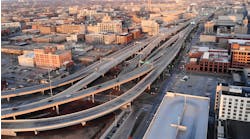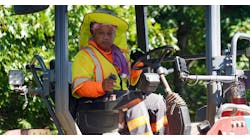Data on traffic collisions involving pedestrians are now routinely available, which, combined with detailed data on road and street networks, facilitate the estimation of models that explain the conditions and circumstances leading to collisions.
Our past research, together with that of others in the fields of transportation engineering and road trauma in public health, has taught us several lessons regarding the safety of pedestrians. Safety here relates to the risk of crash occurrence as well as to the severity of injury once a crash has taken place.
Lesson 1
Pedestrians take the highest risk of colliding with a vehicle when they cross a road or a street. Unfortunately, unsignalized marked crosswalks are known to be highly unsafe. The explanation is that pedestrians feel protected in crosswalks, which then leads them to pay less attention to traffic than they normally would. A fully signalized marked crosswalk should be a traffic engineer’s best approach to shield pedestrians from vehicles. Yet, surprisingly, marked crosswalks with traffic lights or stop signs also are associated with a higher risk of collision occurrence, although these collisions generally result in low-severity or no injury. When the highest engineering safety precautions and measures are not sufficient to guarantee safe behaviors, traffic engineers must partner with law enforcement to discipline unsafe behaviors.
Lesson 2
Models show a lack of association between injury severity and collision frequency, indicating that the locations of collisions resulting in fatality or high-severity injury are not necessarily in the same locations as those with high collision frequency. This means that the strategies to meet Target Zero goals (aiming at zero pedestrian fatalities) that many jurisdictions have adopted must be different from strategies aiming to reduce the number of collisions. Lowering vehicular speeds is most effective in reducing the number of fatal or high-injury collisions, while traffic-calming roadway designs will help decrease the total number of collisions.
Lesson 3
Predictors of the likelihood of a crash occurring or an injury being inflicted are present at three levels, which help to structure collision risk models. At the first level, the strongest explanations come from pedestrians’ and drivers’ sociodemographic characteristics, their behavior and the type of vehicle involved in the collision. The young, the old and the poor are more vulnerable and more likely to be disabled or to die after colliding with a vehicle. Vehicle weight and speed at the time of the collision also are strongly associated with collisions resulting in higher injury severity and fatality.
The second level of explanatory power pertains to the micro street or road environment. Road geometrics, including street width, number of lanes, presence of sidewalks or crosswalks, and traffic controls all contribute to the risk of a collision. Posted speed and traffic volume are two additional road environment characteristics that are highly correlated with level of injury.
Third in contributing to explain collision occurrence is the macro area or neighborhood environment. Densely developed areas have high volumes of pedestrians because they contain many destinations that can be reached on foot more quickly and more inexpensively than by other travel modes.
The accompanying table (Table 1) presents the different levels of a model structure and lists the corresponding variables which may populate models. Levels and predictors also help guide the development of countermeasures and to determine which of the E’s (Engineering, Education, Enforcement, Encouragement, etc.) should be addressed.
Lesson 4
Different classes of roads/streets have contrasting rates of fatal or high-injury crash occurrence. For example, fatality rates of Washington state routes are about three times those of the state’s city streets. These high rates are explained by the fact that state routes have generally higher posted and actual vehicular speeds and more lanes, and hence higher traffic volumes than city streets. Because of these differences, analyses, models and countermeasures should be stratified by road/street type. However, because different road types also have different rates of collision frequency, countermeasures aimed at reaching Target Zero goals should consider all street/road types in order to reduce the total number of fatalities and high injury severity. For example, the same 10% reduction in fatal crashes on state route, city streets and other roads would yield a total reduction of 6-8 such crashes per year, with each one of these road types contributing to 33%, 47% and 20% of the total reduction, respectively.
Table 1. Different Levels and Variables of a Model Structure
Lesson 5
The large amounts of data that now facilitate analyses still need to be improved to avoid bias in model results. First, data completeness is challenged by the underreporting of low or no injury collisions. Studies of hospital visit records indicate that up to 20% of collisions may not have been reported to the police. Second, collision location accuracy varies and depends on police record data quality. We estimate that up to 15% of the collision locations may be wrongly assigned to intersections. Since pedestrians and drivers can take many more directional actions at intersections than along the roadway, it is critical to discern the exact location of a crash.
Missing data at all three levels of prediction mentioned above also compromise model results. At the level of individual sociodemographic and behavioral characteristics, we find that more than 50% of the Washington state crash records have missing gender and vehicle type data. There are good data on pedestrian clothing, but no data on jaywalking. As well, traffic speed at the time of collision is typically not provided (even though it is recorded in FARS—the NHTSA Fatality Analysis Reporting System).
At the micro environmental level, data are often missing or out of date on crosswalks and sidewalks, two important aspects of the road environment. Traffic volumes are not available for most city streets, and neither are actual vehicular speeds (as different from posted speed). In one of our studies, we considered road classification, road geometry and road width as proxy measures for vehicle volume. Sensitivity analyses for sites where both annual average weekday traffic (AAWDT) and proxy measures were available showed that road classification was preferable to AAWDT for predicting pedestrian crash risk.
Finally, at the macro environment level, the lack of exposure data on the number of pedestrians using road facilities continues to hinder modeling efforts. Proxy variables have been used with some success. They include density measures of conditions known to be associated with pedestrian travel such as residential units, jobs and transit ridership; socioeconomic indicators such as neighborhood income, property values, etc.; and various land-use designations that act as “attractors” of pedestrian activity (e.g., schools, retail facilities). Further validation of these proxy variables is needed using available pedestrian counts and other data from local sources.
Lesson 6
Predicting collisions is a tricky business. Thankfully, pedestrian crashes, and particularly those ending in fatality or high injury, are rare events relative to the extent of the road network length or the number of vehicles. As such, collision data yield a limited number of observations, forcing analyses to use multiple years of data. Yet simply aggregating collisions at specific locations across multiple years disregards spatial and temporal differences or even changes in the conditions surrounding individual collisions. Collisions occurring in one location but at different times may differ not only by season, time of day or night, or weather, but also by road and area environment characteristics. Statistical models with mixed fixed and random effects (or parameters) can account for spatio-temporal correlation and help overcome this limitation.
Lesson 7
New tools such as Kernel Density Estimate (KDE) techniques greatly help visualize the location of concentrations of collisions with different injury outcomes. KDE analyses can use either simple descriptive data (e.g., heat maps of collision frequency) or more sophisticated location-based predicted risk of collision occurrence or injury severity (hotspot maps). Using GIS, KDE maps can be generated at any scale of interest (ranging from a neighborhood to an entire state—Figure 1).
Last but not least
The public health sector is increasingly paying attention to walking, because it is the most popular form of physical activity in our otherwise sedentary population. Along with cyclists, walkers are called “active travelers.” Safe and friendly roads and streets help people substitute vehicular trips with ones using active travel modes, thus reducing such negative byproducts of private automobile travel as traffic congestion and environmental degradation. Active modes yield long-term health benefits. Children and youth are prime beneficiaries of Safe Routes to School programs because parental fear of traffic is an important barrier to children walking. Also, however, research indicates that pedestrians often moderate collision risk by using routes with a lower risk of collisions.



